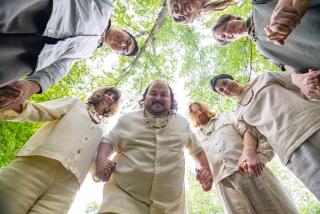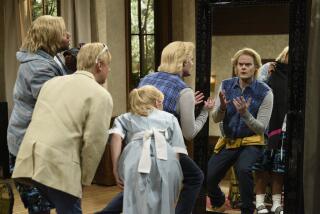Bran Ferren: Master of Arts and Sciences
- Share via
Bran Ferren is an affable, red-haired, round-faced whiz person. Neither face nor name sets off a large clanging of bells, but Ferren and his team bear responsibility for, among many other items in and out of film, that hungry and ever-growing plant in “Little Shop of Horrors.”
They also did hallucinatory passages in “Altered States,” Ferren’s first film, and a tornado for the Sally Field film “Places in the Heart.” They helped on “Star Trek V” and the forthcoming “Second Sight.”
Ferren did his first Broadway stage work, lighting and special effects, for “Crucifer of Blood,” and subsequently lent his hand to “Evita,” “Cats” and “Sunday in the Park with George.”
He has done TV commercials and still photography--a wine glass on a glacier, that kind of thing. Now, Ferren has made his first feature, “Funny,” which opens Sept. 22 at the Monica 4-Plex in Santa Monica and which, I think it fair to say, is unusual.
What Ferren did was persuade more than 100 people to stand in front of a fixed camera and tell their favorite jokes, some 2,000 of them. He shot 150,000 feet of 35-millimeter film, on everybody from Dick Cavett, Eli Wallach and Anne Jackson to a gun-store clerk in North Carolina, a bartender and passers-by on street corners, more unknowns than knowns.
“I wanted something I could do in bits, without actors or continuity,” Ferren said the other afternoon on the roof of a West Hollywood hotel, where he shot some of the jokes. He needed a project he could do while he was doing everything else.
The everything else includes designing the opticals for Revo sunglasses, possibly the most expensive extant at upwards of $150, and involving 30 layers of film to filter unwanted rays. It also includes optical projects for the Navy and NASA and devices for film, including a new optical printer that received one of the three scientific awards Ferren and his partners have had from the motion picture academy.
Ferren attended high school and MIT but did not, he says, wait around for a diploma from either. “I come from a family of artists,” Ferren says, “and one side of me was going to be an artist and the other side a scientist.”
Then it was as if an occult hand had made a mystical sign above him and whispered, “Both, both.”
He started young, he says, doing lighting for summer-stock productions. In no exact sequence, he designed the lighting and light shows for the Electric Circus and Studio 54 discos in New York, created the traveling light show for an Emerson, Lake & Palmer tour (his first venture in that milieu; he has since designed a Paul Mc-Cartney tour).
“It’s like never having to grow up,” Ferren says. “If you can be gainfully employed but no one knows exactly what you do, people will say you’re a genius.”
These days, Ferren is actually Associates and Ferren, a 40-person outfit headquartered in Long Island’s East Hampton, augmented to as many as 100 when in the grip of a special project like “Little Shop of Horrors.”
“And we all work on everything, the theme parks, the museums and the research in optical computation. That’s something, optical computation instead of computers--working with the speed of light.”
In this mating of the arts and the sciences his gift is, Ferren says, essentially as the matchmaker. “I take ideas, which often deal with intangibles, and translate them into tangibles. I know how art and technology can intersect. And we figure out how to use technology in a transparent fashion” (that is, so the ends not the means draw the attention).
The sunglasses, he says, were an interesting case. “They said, ‘Can you design the best sunglasses in the world?’ I said, ‘Yes.’ What else could I say? It was a great challenge, aesthetic because they had to look great and a serious scientific project because they had to do a better job of filtering the rays.” The glasses, not yet available in prescription, are selling embarrassingly well, Ferren says.
“I succumb to obvious distractions,” he says, which is why he made “Funny” so primer simple, to prove he could work without technology or special effects. He did the camera work himself (the cinematographer is listed as I.C. Dailies, which approximates the level of humor of some of the jokes).
“It’s not a film about jokes, it’s a film about people.” It is indeed closer to “Candid Camera” than to “Richard Pryor Live.” A lot closer.
Among the fascinations for Ferren were how widely and fast jokes travel. In one instance, he cuts between three or four people telling the same joke at different times in different places.
There are many Jewish jokes. No anti-Semitism, Ferren thinks; most of the jokes are told by Jews and reflect, in his view, a long history of storytelling among Jews. A few of the crudest jokes are told by women. Ferren has no explanation; it may be an aspect of liberation, a kind of down-shifted equality.
Ferren is working up two new and entirely dissimilar film projects. One, he says, is a $30-million special-effects film that he can do for $7 million. The other is a small love story involving three people that could be done for less than half a million.
“I know it would be easier to sell the studios on the big one than the small one. And a side of me says I’d prefer to do the $350,000 film with a sad ending. The fact is I’ll be happy to do either.”
My favorite joke from “Funny” has St. Peter doing a small survey of new arrivals, asking how much they earned. The first man, a lawyer, says he made $250,000 last year. The stockbroker says he made $600,000. The third man, unidentified, says he made $6,000. ‘Ah,” says St. Peter, “was there something I would have seen you in?”
Ferren’s high school eventually gave him a diploma, figuring that his post-curricular achievements made up for the missing credits.
More to Read
Only good movies
Get the Indie Focus newsletter, Mark Olsen's weekly guide to the world of cinema.
You may occasionally receive promotional content from the Los Angeles Times.










